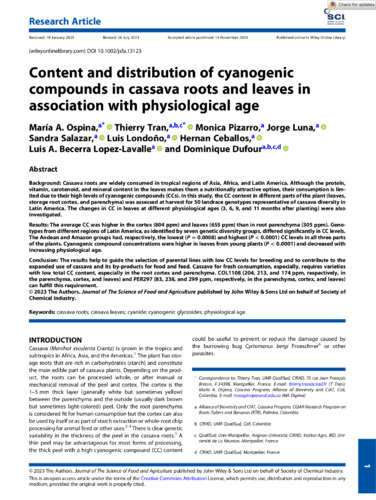Content and distribution of cyanogenic compounds in cassava roots and leaves in association with physiological age
Background Cassava roots are widely consumed in tropical regions of Asia, Africa and Latin America. Although the contents of protein, vitamins, carotenoids and minerals in the leaves make them a nutritionally attractive option, their consumption is limited due to their high levels of cyanogenic compounds (CC). In this study, CC content in different parts of the plant (leaves, and storage root cortex and parenchyma) was assessed at harvest for 50 landrace genotypes representative of cassava diversity in Latin America. The changes in CC in leaves at different physiological ages (3, 6, 9 and 11 months after planting) were also investigated. Results Average CC were higher in the cortex (804 ppm) and leaves (655 ppm) than in root parenchyma (305 ppm). Genotypes from different regions of Latin America, as identified by seven genetic diversity groups differed significantly in CC levels. The Andean and Amazon groups had, respectively, the lowest (P=0.0008) and highest (P<.0001) CC levels in all three parts of the plants. CC concentrations were higher in leaves from young plants (P<.0001) and decreased with increasing physiological age. Conclusion Results help guide the selection of parental lines with low CC levels for breeding and to contribute to the expanded use of cassava and its by‐products for food and feed. Cassava for fresh consumption, especially, requires varieties with low total CC content, especially in the root cortex and parenchyma. COL1108 (204, 213 and 174 ppm, respectively, in the parenchyma, cortex and leaves) and PER297 (83, 238 and 299 ppm, respectively, in the parenchyma, cortex and leaves) can fulfill this requirement. This article is protected by copyright. All rights reserved.

